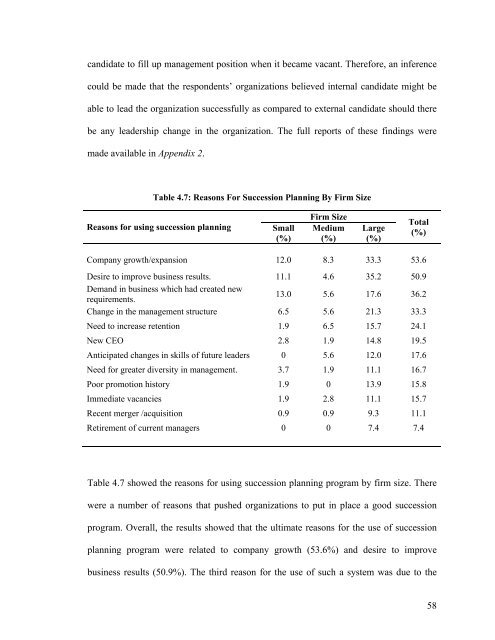CHAPTER 1: INTRODUCTION 1.0 Chapter Overview - DSpace@UM
CHAPTER 1: INTRODUCTION 1.0 Chapter Overview - DSpace@UM
CHAPTER 1: INTRODUCTION 1.0 Chapter Overview - DSpace@UM
You also want an ePaper? Increase the reach of your titles
YUMPU automatically turns print PDFs into web optimized ePapers that Google loves.
candidate to fill up management position when it became vacant. Therefore, an inferencecould be made that the respondents’ organizations believed internal candidate might beable to lead the organization successfully as compared to external candidate should therebe any leadership change in the organization. The full reports of these findings weremade available in Appendix 2.Table 4.7: Reasons For Succession Planning By Firm SizeReasons for using succession planningSmall(%)Firm SizeMedium(%)Large(%)Total(%)Company growth/expansion 12.0 8.3 33.3 53.6Desire to improve business results. 11.1 4.6 35.2 50.9Demand in business which had created newrequirements.13.0 5.6 17.6 36.2Change in the management structure 6.5 5.6 21.3 33.3Need to increase retention 1.9 6.5 15.7 24.1New CEO 2.8 1.9 14.8 19.5Anticipated changes in skills of future leaders 0 5.6 12.0 17.6Need for greater diversity in management. 3.7 1.9 11.1 16.7Poor promotion history 1.9 0 13.9 15.8Immediate vacancies 1.9 2.8 11.1 15.7Recent merger /acquisition 0.9 0.9 9.3 11.1Retirement of current managers 0 0 7.4 7.4Table 4.7 showed the reasons for using succession planning program by firm size. Therewere a number of reasons that pushed organizations to put in place a good successionprogram. Overall, the results showed that the ultimate reasons for the use of successionplanning program were related to company growth (53.6%) and desire to improvebusiness results (50.9%). The third reason for the use of such a system was due to the58
















